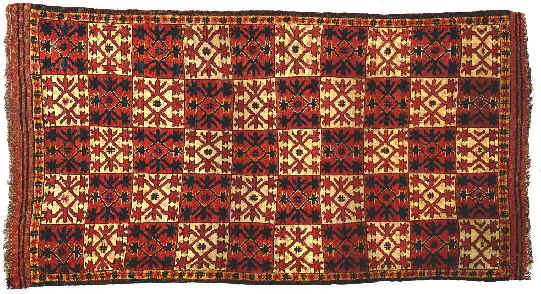|
|
Turkmen, specially after October Revolution, attained a new way of life; before that, although they mostly used to be suppressed at North by Russian and at South by Iranian, had freedom in choosing their environment, using their power and migration; but since independence, they had more and more tendency to an urban life. This tendency took place specially in Turkmenistan and other new independent Turkish residents. In Iran, This press took place very slowly.
Turkmen, now are living mainly in Turkmenistan, North of Iran, North-west of Afghanistan and some republics of Central Asia, like Uzbekistan.
All this decamping and evolution made change in their woven. Natural dyes are almost vanished and looms became vertical. Carpet weaving is limited, new designs with new subjects, like images of historical, national and political characters, images of people, subjects showing national events, feasts and commemorations have replaced repetitive and monotonous designs of old time.
In Iran and Afghanistan, keeping on old patterns continues. In Afghanistan, situation is a little better than Iran, because, some specifications in accordance with tribal work still are in use with Turkmen carpets. In Europe, this specialty is known as "Exotic": variety, purity, sense of aptitude plus fine and accurate weaving.
Acquaintance of Iranian with Turkmen carpet, is a factor of prosperity of this carpet, otherwise, it is not utterly known in world market; also features of this carpet became limited and no more trump prayer-niche or garden design is woven at present; only "Kharchin Gul" and "Gazelle" in limited size are woven.
Turkmen's weaving, due to some attractiveness's, such as pictured carpets or benefiting modern subjects )subjects chosen from normal life, face of men ad women at work, life, dance and feast) are not unwanted out of production limits, though it is slightly wove and could not satisfy the market.
Turkmen carpet, until 20th century has followed old patterns, but during last fifty years, everything changed in Iran. In fact, Iranian Turkmen did not care much on carpet weaving and this business was declined un that region.
Until 20th century, a principal part of Turkmen carpets were woven in Turkmen residing regions of North frontier of Iran. Carpets were sold mainly in Meshed and then transported to Tehran; in Pahlavi era, government confiscated their lands, following the act of Land Reforms; so Turkmen's living changed compulsorily, and they directed to carpet weaving,
Now, three tribes of Turkmen have the business of carpet weaving: Two of "Yamut" and a part of "Tekkeh" clans. They have migrated to Iran at about beginning of 20th century.
Yamuts have two sects of "Atabay" and "Jafarbay". "Tekkeh" are residing in "Jargalan" and have created the best weavings of Iranian Turkmen. Their main residence is at "Maraveh-Tappeh", but their weaving is not as much as two clans of Yamut.
"Atabay", in weaving art, stands after "Tekkeh", but weaves the highest quantity of carpet. Around 1952, Atabay wove half product of Iranian Turkmen carpets and mostly sold in "Gonbad Qabous".
"Jafarbay" stands after "Atabay", while its production is less than the former and sold in "Aq-qaleh" and "Gorgan Thursday Market".
Products were woven by women on horizontal loom, inside their tents (and now on vertical loom in their houses), where weaving smaller pieces is easier. They use wool for warp and weft, benefiting their own sheep for wool. Between two World Wars, natural dyes, such as madder and cochineal were vanished and replaced by synthetic dyes.
During Second World War, Turkmen carpets of Iran basically changed; old patterns were forgotten and only designs of "Bukhara", being unobtainable and expensive, was in demand. Merchants and Turkmen found a good income source due to familiarity with Bukhara designs. Old dark red color vanished and replaced by Aniline (madder red) color.
Turkmen woven of desert weave their carpets and rugs single-wefted. In Turkmen carpets, we encounter with a source of esthetic of labor and quest of crowd, collected by consecutive generations. Carpet, for tent-dwellers is not an ornamental or diversion mean, but a necessity of rich and poor. Carpet, first of all, is used to cover up mobile houses of felt, as a furniture. Their tent consists of a dismountable scaffold covered by mat and felt.
Entrance of the tent is closed by a special rug, called “Ensi”. Turkmen sit and sleep on the felt or rugs spread on the floor. When Turkmen leaves his place for a trip, takes along his felt saddle (Namazlik), prayer rug and a pair of woven siliques. In fact, rug is always a companion of Turkmen, all long his life and his decamping object. At present, this tribal art is missing their special quality and character, also in connection with carpet. Not only finesse of design, but also beauty of colors, sustain a loss.

Beshir Rug: 1.80x1 m, (19th century)
|
|

